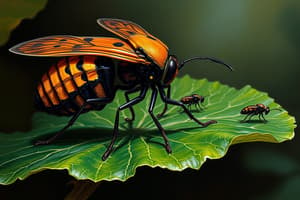Podcast
Questions and Answers
What is the key event that marks the transition from the juvenile form to the adult form in insects undergoing complete metamorphosis?
What is the key event that marks the transition from the juvenile form to the adult form in insects undergoing complete metamorphosis?
- The insect emerges from the pupal case and stretches out its newfound form.
- The insect stops moving and appears dormant within its protective casing. (correct)
- The insect begins feeding voraciously to prepare for the pupal stage.
- The insect sheds its exoskeleton to reveal the adult form.
What is the primary function of the pupal stage in the complete metamorphosis of insects?
What is the primary function of the pupal stage in the complete metamorphosis of insects?
- The pupal stage enables the insect to shed its exoskeleton and reveal the adult form.
- The pupal stage is a resting period where the insect does not undergo any changes.
- The pupal stage allows the insect to store energy for the adult stage.
- The pupal stage protects the insect while it undergoes structural changes. (correct)
What is the purpose of the insect's exoskeleton hardening during the adult stage?
What is the purpose of the insect's exoskeleton hardening during the adult stage?
- To enable the insect to reproduce and lay eggs.
- To allow the insect to begin feeding and moving freely.
- To provide additional protection for the insect's delicate new form. (correct)
- To signify the completion of the insect's metamorphosis.
Which of the following insect orders is NOT mentioned as an example of the four-stage life cycle described in the text?
Which of the following insect orders is NOT mentioned as an example of the four-stage life cycle described in the text?
What key adaptation do insects demonstrate through their complete metamorphosis, as mentioned in the text?
What key adaptation do insects demonstrate through their complete metamorphosis, as mentioned in the text?
What is the primary reason why larvae consume multiple times their body weight daily during complete metamorphosis?
What is the primary reason why larvae consume multiple times their body weight daily during complete metamorphosis?
In the context of complete metamorphosis, what major difference exists between larvae and the early stages in incomplete metamorphosis?
In the context of complete metamorphosis, what major difference exists between larvae and the early stages in incomplete metamorphosis?
What is the significance of the pupal stage in complete metamorphosis?
What is the significance of the pupal stage in complete metamorphosis?
Why are instars compared to human developmental phases like infancy, adolescence, and adulthood?
Why are instars compared to human developmental phases like infancy, adolescence, and adulthood?
What differentiates insect metamorphosis into egg, larva, pupa, and adult stages from incomplete metamorphosis?
What differentiates insect metamorphosis into egg, larva, pupa, and adult stages from incomplete metamorphosis?
How does the voracious appetite of larvae contribute to their development during complete metamorphosis?
How does the voracious appetite of larvae contribute to their development during complete metamorphosis?
Study Notes
Metamorphosis in Insects: Understanding Complete Metamorphosis
Metamorphosis is a vital aspect of insect development, particularly for species that go through complete metamorphosis. This fascinating transformation involves four distinct stages: egg, larva, pupa, and adult. Each stage represents a significant shift in the insect's form, and together, they contribute to the complex life cycles observed in these creatures.
Stage 1: Egg
The journey of complete metamorphosis begins with the hatching of an insect from an egg into a soft, worm-like creature known as a larva. Unlike incomplete metamorphosis, where the early stages closely resemble the adult form, insects undergoing complete metamorphosis experience profound differences between their various stages.
Stage 2: Larva
Larvae are characterized by voracious appetites, capable of consuming multiple times their own body weight daily. As they consume vast amounts of food, they enter a rapid growth phase. While humans might consider such consumption unhealthy, for insects, it facilitates swift development.
Instars
Throughout their larval stage, insects go through a series of incremental developments, referred to as instars. Similar to human development phases like infancy, adolescence, and adulthood, these stages reflect the progression of the organism towards maturity.
Stage 3: Pupa
Once the larval stage concludes, the insect enters the pupa stage. This phase marks the transition from a juvenile form to an adult form. Notably, the pupa ceases to eat and move, seemingly lying dormant within its protective casing. However, this period is anything but uneventful; internally, the insect is undergoing a remarkable structural overhaul, converting itself into a fully formed adult.
Stage 4: Adult
Finally, upon completing the pupal stage, the insect emerges as a mature adult. Freed from the confines of the pupal case, the insect must first stretch out its newfound form. During this time, the exoskeleton gradually hardens, absorbing moisture from the environment before reaching its final state.
This four-stage life cycle characterizes many common insect orders, including beetles, bees, ants, butterflies, moths, fleas, and mosquitoes. Despite their initial striking differences, all stages share the same genetic makeup, demonstrating the incredible versatility of insect DNA and evolutionary adaptations.
Studying That Suits You
Use AI to generate personalized quizzes and flashcards to suit your learning preferences.
Description
Test your knowledge on the fascinating transformation process of complete metamorphosis in insects, encompassing four distinct stages: egg, larva, pupa, and adult. Explore how each stage contributes to the intricate life cycles observed in various insect species.


